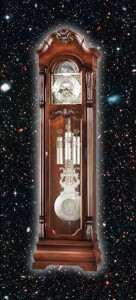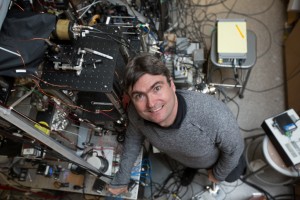 A very special clock that can measure time on the basis of the mass of a single atomic or even subatomic particle holds promise not only for ultraprecise measurements of mass and time, but also for such exotic applications as testing Einstein’s general theory of relativity, or the effects of gravity on antimatter.
A very special clock that can measure time on the basis of the mass of a single atomic or even subatomic particle holds promise not only for ultraprecise measurements of mass and time, but also for such exotic applications as testing Einstein’s general theory of relativity, or the effects of gravity on antimatter.
“We have directly demonstrated the connection between time and mass,” says Holger Müller, physics professor at the University of California (UC), Berkeley and guest scientist with Berkeley Lab’s Chemical Sciences Division, who led the team of Berkeley researchers who developed the clock and reported it in the journal Science.
“Since the ticking rate of our clock is equivalent to knowing the mass of an atom, we can use it to make a mass standard based on time,” Müller says.
The Berkeley team calls their device a “Compton frequency clock” for the oscillation frequency of de Broglie matter waves (about 10 billion times that of visible light). The clock was constructed using an atom interferometer, which measures matter waves, in combination with an optical frequency comb, which can be used to measure exceptionally high oscillation rates and accurately compare them to lower frequencies. The clock runs on laser-trapped cesium-133 atoms, which were chosen over subatomic particles because they are electrically neutral and can approximate non-interacting point masses.
“Historically, time measurements have been based on oscillation frequencies in systems of particles, from the motion of celestial bodies to atomic transitions,” Müller says. “In principle, a Compton-frequency clock could be built by annihilating a particle-antiparticle pair and counting the frequencies of the generated photons, but the results are far beyond modern counting techniques. With the combination of an atom interferometer and an optical frequency comb, we can measure the small difference in frequencies between waves representing the moving atom and waves representing the atom at rest to get results that are within a technically accessible range.”
The Berkeley team reports that their Compton frequency clock is comparable in accuracy to the first cesium atomic clocks but could eventually be improved to become the most accurate time-keeper possible, or be constructed as an antimatter-based clock for testing particle/antiparticle symmetry. Already, it can be used to provide a new definition of the kilogram.
“Our clock shows that quantum mechanically, mass can be used to measure time and vice versa,” Müller says.
To read the UC Berkeley news release on this work go here
